The workshop kept me busy until Saturday morning, which left me a day to explore before I had to head back across the Mississippi for home. I also had good friends to visit at the University of Iowa Hospital in Iowa City before Tamu and I checked out of the hotel that had been home for almost a week. After a week of unseasonably cool weather, our final day was full of humidity and grew hotter as the sun appeared. So my plans for the day would be somewhat determined by whether I could let Tamu out of the car as I meandered along.
We headed to the place close by, but which I knew little about, the Amana Colonies. The name refers to a collection of settlements constructed by members of a German pietist movement that became known as the Community of True Inspiration. Pietism was a movement in the late 1600s within Lutheranism that emphasized individual piety and living a distinctive Christian life in community, over the theological debates and doctrinal emphasis of the early Lutheran Church. Pietism would eventually influence other denominations in Protestantism, and inspire the creation of Methodism. This was not my first encounter with such communities, as a number of German pietists set up similar communities I had visited in Ohio. In the Iowa case, the community that began in Germany in 1714 eventually moved to America around 1843-44. This group worked cooperatively and shared resources, first purchasing land in Buffalo, NY before moving to Iowa in 1855 because they could purchase a tract of around 26,000 acres near the Iowa River. They chose the name Amana to indicate their faithfulness, and established six villages on the land: Amana proper, and East, West, South, High, and Middle Amana. They later purchased another town, Homestead, to give the community access to a railroad depot.
Members of the community lived collectively in a non-cash economy. Property and resources were shared, and work was assigned by the village council. Members received housing, medical care, meals, household necessities, and schooling at no cost. Inspirationists attended church services 11 times per week, farmed, and produced wool and calico. They also became known for their well-crafted products. Over 50 communal kitchens served five meals each day, except on Sunday, when the respite from farming labor slowed the food preparation to three meals. This lasted until 1932, when the Great Depression dampened the ability of the community to sell its produce, and the elders became concerned that the adherence to their communal way of life was limiting options for their children. So, in the height of the Depression, they created the Amana Society, Inc., a profit-sharing corporation to manage the larger enterprises, and community members were issued a salable share that offered benefits, including burial rights. Private enterprise was encouraged, and one of its members went on to create the Electrical Equipment Company in Middle Amana, which later became Amana Refrigeration before moving into air conditioners and microwave ovens, which made it a household name. That Amana is currently a division of Whirlpool and earns $4.7 billion in revenue annually, according to Wikipedia. The current Inspirationist community–later known as the Ebenezer community–numbers around 1600, and they still engage in communal worship services.
All this was unknown to me when I first arrived in Amana town, which has a long main street full of craft and produce stores, as well as wineries and a few heritage sites. 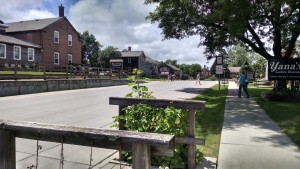 I was instantly reminded of Amish and Pietist communities dotting Ohio, and assumed that I would encounter a lot of shoppers and little of the history. But I was proved wrong. After a walk along the main street with Tamu to get my bearings, I headed for the Amana Heritage Museum. Because of the heat, I did not expect to take in the main building for long because it would be inhumane to leave a dog in the car. However, when I asked at the desk about bringing him inside, the docent enthusiastically welcomed him. Apparently,
I was instantly reminded of Amish and Pietist communities dotting Ohio, and assumed that I would encounter a lot of shoppers and little of the history. But I was proved wrong. After a walk along the main street with Tamu to get my bearings, I headed for the Amana Heritage Museum. Because of the heat, I did not expect to take in the main building for long because it would be inhumane to leave a dog in the car. However, when I asked at the desk about bringing him inside, the docent enthusiastically welcomed him. Apparently, 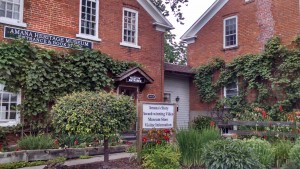 Amana’s Heritage Society went pet friendly some time ago, and dogs are allowed everywhere. This was great news for Tamu, who has a particular interest in 17th century Protestantism, and friendly people who scratch his ears while I read the historical placards. It was also great news for me because I had no idea how I would manage him and touring in this weather, and this solved it.
Amana’s Heritage Society went pet friendly some time ago, and dogs are allowed everywhere. This was great news for Tamu, who has a particular interest in 17th century Protestantism, and friendly people who scratch his ears while I read the historical placards. It was also great news for me because I had no idea how I would manage him and touring in this weather, and this solved it.
The museum program began with an excellent film that laid out the history of the community until 1932. I must admit that it ended with a sense of loss, and I assumed the decision to create a for-profit corporation was the death knell for the Ebenezer community. Tamu and I moved through the 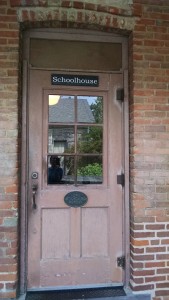 buildings on the museum grounds learning more about the daily life of the Inspirationists back in the day. Upon finishing our walk, I decided to take advantage of Ackerman Winery/Heritage Haus, which shares the museum parking lot. I politely (and quickly) sampled some of the cheese and jelly that is featured on the building, before heading to taste some of their wine. To my delight, Ackerman offers a full menu of non-grape wines, so I settled on two bottles, one an autumn blend and the other a dandelion wine, my first.
buildings on the museum grounds learning more about the daily life of the Inspirationists back in the day. Upon finishing our walk, I decided to take advantage of Ackerman Winery/Heritage Haus, which shares the museum parking lot. I politely (and quickly) sampled some of the cheese and jelly that is featured on the building, before heading to taste some of their wine. To my delight, Ackerman offers a full menu of non-grape wines, so I settled on two bottles, one an autumn blend and the other a dandelion wine, my first.
Then Tamu and I headed off to the other villages. Our admission ticket included the Communal Kitchen in Middle Amana and Community Church Museum in Homestead. We stopped along the way at the gates to the Amana company (with its No Trespassing signs), then were off to the kitchen. At its height, the community supported 50 communal kitchens, in which senior women directed younger ones in meal preparation to support the farm labor of the men. These women put on three main meals each laboring day, with two substantial snacks as well. The guide at the kitchen was friendly and talkative. I was not aware then that Tamu was allowed in 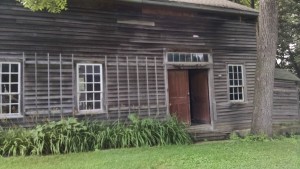 all buildings, so I left him outside for my visit, then walked him over to the Cooper Shop across the way, which was self-guided. I had not realized that coopers make barrels until Amana schooled me.
all buildings, so I left him outside for my visit, then walked him over to the Cooper Shop across the way, which was self-guided. I had not realized that coopers make barrels until Amana schooled me.
We headed to Homestead next, for it boasted not only the church but the village market and adjacent winery. This time, I secured Tamu’s leash to a post outside before entering the meeting house, where I met a practicing member of the Ebenezer Community of Inspirationists. After her very informative discussion of the structure, she very helpfully answered all 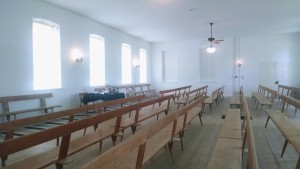 my questions about the community. From her, I learned that the film is a bit nostalgic about the old days of communal living, but that–in her opinion–the community as thrived with the move to private enterprise in ways that would not have been true had they made a different decision in 1932. Her belief is that the community would have lost most of its younger people and, like many of the Ohio communities I have already seen, the villages would be a relic now rather than thriving. The community has two meeting halls (their name for church) in addition to the museum I was visiting with her, and a Sunday School
my questions about the community. From her, I learned that the film is a bit nostalgic about the old days of communal living, but that–in her opinion–the community as thrived with the move to private enterprise in ways that would not have been true had they made a different decision in 1932. Her belief is that the community would have lost most of its younger people and, like many of the Ohio communities I have already seen, the villages would be a relic now rather than thriving. The community has two meeting halls (their name for church) in addition to the museum I was visiting with her, and a Sunday School 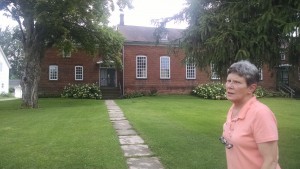 where young members meet prior to joining the full church at Confirmation. Worshippers share a capella singing, Scripture, and writings by inspired members of the community. Interestingly, I also learned that the community does not bury families together in the graveyard, but each member of the community is buried in the order in which they die, next to whoever died just before them.
where young members meet prior to joining the full church at Confirmation. Worshippers share a capella singing, Scripture, and writings by inspired members of the community. Interestingly, I also learned that the community does not bury families together in the graveyard, but each member of the community is buried in the order in which they die, next to whoever died just before them.
She and I walked out to find Tamu waiting patiently, and she gently scolded me for not bringing him inside the church. I went from her to the town general store and winery, and found the latter to be 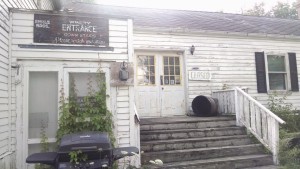 largely abandoned. So we looked at the map, and decided to use the rest of our time in the colonies shopping in Amana. I looked at some local craft and sampled some more wine as the humid Saturday sped on. I had decided to spend the night in Iowa City because the next day’s trip back to Washington would be quite long already, without the addition of more travel. So Tamu and I headed back, and I looked at taking in some of the wine trail further south or even heading to Burlington. In the end, we decided to leave the corners of the state for future visits to Iowa, and had a restful night before heading back across the Mississippi for home.
largely abandoned. So we looked at the map, and decided to use the rest of our time in the colonies shopping in Amana. I looked at some local craft and sampled some more wine as the humid Saturday sped on. I had decided to spend the night in Iowa City because the next day’s trip back to Washington would be quite long already, without the addition of more travel. So Tamu and I headed back, and I looked at taking in some of the wine trail further south or even heading to Burlington. In the end, we decided to leave the corners of the state for future visits to Iowa, and had a restful night before heading back across the Mississippi for home. 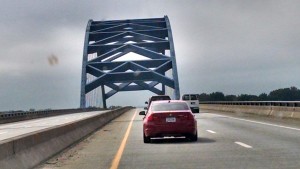 We hope to be back for the combination of touring and writing–and even a presidential candidate or two–soon!
We hope to be back for the combination of touring and writing–and even a presidential candidate or two–soon!
